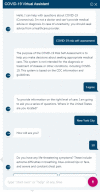RSNA International Trends: A Global Perspective on the COVID-19 Pandemic and Radiology in Late 2020
- PMID: 33289616
- PMCID: PMC7734846
- DOI: 10.1148/radiol.2020204267
RSNA International Trends: A Global Perspective on the COVID-19 Pandemic and Radiology in Late 2020
Abstract
The coronavirus disease 2019 pandemic has challenged and changed health care systems around the world. There has been a heterogeneity of disease burden, health care resources, and nonimaging testing availability, both geographically and over time. In parallel, there has been a continued increase in understanding how the disease affects patients, effectiveness of therapeutic options, and factors that modulate transmission risk. In this report, radiology experts in representative countries from around the world share insights gained from local experience. These insights provide a guidepost to help address management challenges as cases continue to rise in many parts of the world and suggest modifications in workflow that are likely to continue after this pandemic subsides.
© RSNA, 2021.
Figures







References
-
- RSNA News article: https://www.rsna.org/news/2020/June/COVID-Open-Radiology-Database.
-
- Wong HYF, Lam HYS, Fong AH, Leung ST, Chin TW, Lo CSY, Lui MM, Lee JCY, Chiu KW, Chung TW, Lee EYP, Wan EYF, Hung IFN, Lam TPW, Kuo MD, Ng MY. Frequency and Distribution of Chest Radiographic Findings in Patients Positive for COVID-19. Radiology 2020;296(2):E72-e78. doi: 10.1148/radiol.2020201160. - PMC - PubMed
Publication types
MeSH terms
LinkOut - more resources
Full Text Sources
Other Literature Sources
Medical

